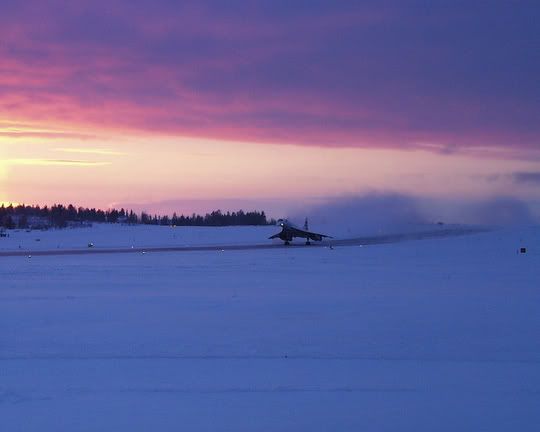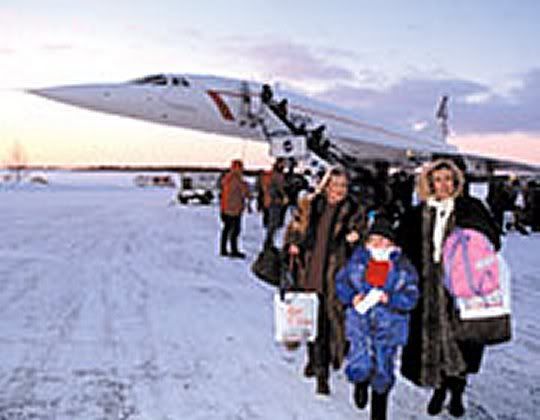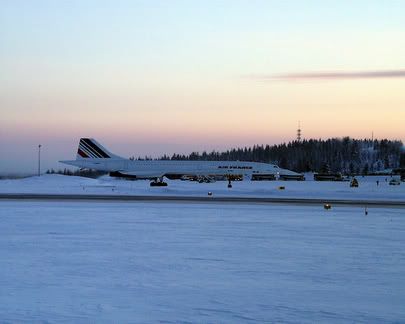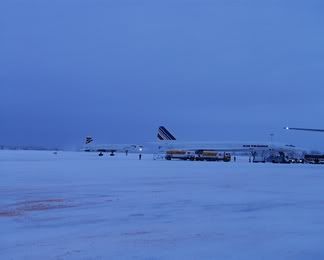September 09, 2010, 22:28:00 GMT
permalink Post: 5925300
Barbara Harmer at British Airways.
The first female Concorde airline pilot.
She became F/O on Concorde in 1993.
After the end-of-service, she continued to fly 777s with BA.
.
B\xe9atrice Valle at Air France.
After a long career as a pilot, she finally was selected for Concorde... and then the Paris crash happened.
But she persisted, and in the end she did 35 return flights CDG-JFK before the final end-of-service.
She then became captain on 747s.
Apart from Jacqueline Auriol , well-known French 'aviatrice' and test pilot, who flew once on the Concorde prototype, I do not know of anybody else.
And no, there is no record of any female F/Es.
CJ
Subjects
Air France 4590
Barbara Harmer
Boeing 747
British Airways
Captains
Female Pilots
Links are to this post in the relevant subject page so that this post can be seen in context.
Reply to this quoting this original post. You need to be logged in. Not available on closed threads.
September 09, 2010, 23:14:00 GMT
permalink Post: 5925378
I've only been on a Concorde flight once, and since that was the last-but-one Air France "round-the-bay", it's fairly obvious the very special party atmosphere on that flight was not quite the same a on a regular flight.
But from what I've read from other "trip reports", even a regular Concorde flight was never quite like a flight on any other aircraft.
So, welcome, and if you have any CC stories to relate... yes, please !
CJ
PS -- Can you imagine anybody doing a "trip report" about the usual eight boring hours on a 777 flight from CDG to JFK ??
And I'm sure you've often have seen the "Concorde grin" during your flights ....
Subjects
CDG
Cabin Crew
JFK
Round the Bay
Links are to this post in the relevant subject page so that this post can be seen in context.
Reply to this quoting this original post. You need to be logged in. Not available on closed threads.
September 11, 2010, 15:59:00 GMT
permalink Post: 5928677
It's a halfway interesting "what if" question...
Bearing in mind the c.g. is already almost over the main wheels... could it have been done by moving the c.g. as far back as possible, keeping the droop nose at 0\xb0, and after touchdown keeping the nose off the ground for as long as possible?
The radome would have shattered, but the droop nose structure would have acted like a skid.
Just as well nobody ever needed to try it.
There is only one well-known case of a landing gear problem.
Visualise a moment the main landing gear. The main leg 'l' is held down in the vertical position by a large hydraulic "stay" '\' .
___
\l
(I know that, to most people, it looks at first like the retraction cylinder, but it isn't. The retraction cylinder is much shorter, and inside the wheel bay.)
Now the story... It happened during what was going to be the last-but-one flight of the British prototype, 002, during a demonstration flight at Weston-super-Mare.
After a slow pass with the gear down, the co-pilot flying the aircraft put it into a steep turn, retracting the gear at the same time.
The next moment, there was a very loud bang, and one of the main gear lights did not go "green".
Somebody from the crew went to the back cabin, where there is a small porthole to look into the wheel well. When asked what he could see, the answer was "nothing..." ; both the main stay and the retraction cylinder had parted company with the aircraft, and the gear leg was dangling free.
The pilot, John Cochrane, took over the controls, and brought the aircraft back to Fairford. With his guardian angel doing overtime, he managed to put down the aircraft and keep it straight during the roll-out, without the gear collapsing.
I didn't see the landing, but I saw 002 in the hangar the next day. By that time a steel bar had been fitted to keep the leg upright, but the damage was still impressive.
Later on, a spare stay was fitted, but 002s flight test career was over. She stayed in storage at Fairford for some time, and was then flown to the Fleet Air Arm Museum in Yeovilton, where she still can be seen to this day.
Wisely, for the few minutes flight, they did not retract the gear....
CJ
Subjects
Fairford
Hydraulic
Landing Gear
Links are to this post in the relevant subject page so that this post can be seen in context.
Reply to this quoting this original post. You need to be logged in. Not available on closed threads.
September 11, 2010, 16:32:00 GMT
permalink Post: 5928729
The first production Concorde (204, G-BOAC) was about a ton heavier than the last on (216, G-BOAF). IIRC most of that was achieved by judicious use of titanium in certain locations.
The aluminium alloy was not Dural, but a special alloy called RR58, AU2GN or hiduminium which was used because of its superior 'creep' properties ('creep' = slow permanent deformation under a combination of mechanical stress and high temperatures).
(As an example of the latter, ever looked at a photo of the top of the wing of a Concorde with all those oval-shaped access panels? They were all machined.

It also made for greater precision and repeatablity, more consistent quality, etc.
And the scrap from the milling operation was recovered and recycled....
CJ
Subjects
G-BOAC
G-BOAF
Links are to this post in the relevant subject page so that this post can be seen in context.
Reply to this quoting this original post. You need to be logged in. Not available on closed threads.
September 11, 2010, 22:24:00 GMT
permalink Post: 5929197
Let's admit that being faced with that nasty situation in reality would not have been amusing....
But kicking the idea around a moment, why not? It's what I did seeing the question at first.
I realise there would be some damage, especially in light of what has been said about the occasional tailwheel contacts but I imagine it would be less than lowering the unprotected forward fuselage onto the runway.

One thing that promptly occurred to me for this 'no nose wheel' scenario is braking, since both engine reverse and main gear wheel braking act below the CG, so they'd both act to pull the nose down.
At some point, stick fully back, hence elevons fully up, will no longer be enough to fully counteract that, so you'll have to cancel reverse and braking, and probably commit to an overrun.
Your scenario of doing it as a 'three-pointer' on the tail might wel be the better one !
And while we're at it, what about ditching a Concorde?
It's hinted at in the Safety Cards.
It's been tried lots of times, with models in water tanks.
It wasn't really feasible.......
CJ
Subjects
Braking
C of G
Elevons
Landing Gear
Tailwheel
Visor
Links are to this post in the relevant subject page so that this post can be seen in context.
Reply to this quoting this original post. You need to be logged in. Not available on closed threads.
September 11, 2010, 22:46:00 GMT
permalink Post: 5929227
There were the early days...
At the time there were only two programs that everyone wanted to be on.
They were Apollo and Concorde.
I was a part of one of those
There were the years after that, when Apollo was cancelled, when only 16 Concordes ever saw service, and one felt the world was no longer going forward.
And for me, there indeed was that immense moment of satisfaction, when I finally flew on one of the last AF Concorde flights, and got my brief cockpit visit, to see that everything I had helped to develop long ago still worked exactly as we'd designed it, close to 30 years later !
CJ
Subjects
Air France
Links are to this post in the relevant subject page so that this post can be seen in context.
Reply to this quoting this original post. You need to be logged in. Not available on closed threads.
September 12, 2010, 19:41:00 GMT
permalink Post: 5930601
Look at my post #260, second diagram, taken directly from the BA Flying Manual.
There is a "first stage warning" (Mach/CG lights and gong) above Mach 1.6 and below Mach 0.45 for the aft CG limit.
It's only in the "corridor" that there is a "second stage warning" (flashing Mach/CG lights and stick shaker).
CJ
Subjects
British Airways
C of G
Stick Shaker
Links are to this post in the relevant subject page so that this post can be seen in context.
Reply to this quoting this original post. You need to be logged in. Not available on closed threads.
September 13, 2010, 14:54:00 GMT
permalink Post: 5932115
In May 1977, aircraft G-BOAA was returned to Filton for some modifications that .....
In "Concorde - The Inside Story" by Brian Trubshaw there is actually a photo of what is almost certainly the same incident.
But there is another story....
After the first-ever landing at Bahrain, a crowd of Very Important Persons was allowed to visit the aircraft.
Of course they had to see it all, including the rear cabin.
Since the aircraft hadn't been refuelled yet, the inevitable happened... the aircraft started slowly but inexorably tilting backwards.
A very undignified stampede towards the front resulted, just in time, so the aircraft did not actually sit on its tail.
But there was a sequel. The incident had been watched by the airport manager, who promptly decreed that from then on a tractor would have to be chained to the nose gear whenever the aircraft was on the ramp.
Urban legend has it, that from then on there was a new item in the pre-taxy checklist for Bahrain.
CHAIN REMOVED FROM NOSEWHEEL - CHECK
CJ
Subjects
Air France 4590
Checklists
Filton
G-BOAA
Landing Gear
Links are to this post in the relevant subject page so that this post can be seen in context.
Reply to this quoting this original post. You need to be logged in. Not available on closed threads.
September 13, 2010, 16:09:00 GMT
permalink Post: 5932223
Don't forget it was you and your colleagues that made the Concorde experience so special just as much as the three guys in the front office, or the ground staff, or the engineers, or us wavers of slide rules.
So yes, the experience from your side is as much part of the "Concorde Story" as ours !
Your description of a typical regular flight is much as I imagined it.
Did you ever do any of the BA 'round-the-Bay' charters?
My only flight was one of the last Air France 'round-the-Bay' flights.
Total duration from take-off to touchdown was only about 1h 50min, yet even so the CC managed to serve us all the classic glass of champagne, a three-course meal that we barely had time to finish, and of course the little box with two choccies... Fauchon in our case.
And all this notwithstanding the steady flow of pax down the aisle, first to have their photo taken next to the Mach meter at M 2.03, and then again for the cockpit visits.
How they managed it I will never know....
CJ
Subjects
British Airways
Cabin Crew
Round the Bay
Links are to this post in the relevant subject page so that this post can be seen in context.
Reply to this quoting this original post. You need to be logged in. Not available on closed threads.
September 15, 2010, 15:40:00 GMT
permalink Post: 5936328
Was there ever any consideration given to fitting one and was the decision against the installation solely a weight issue ?
The subject was dealt with in some depth, and in the course of the discussion is was described how the two preproduction and the first two production aircraft were equipped with an MEPU (monopropellant emergency power generator).
I've only just found this photo again... it's the MEPU of Delta Golf (202 - G-BBDG).
The photo was taken after 'DG was moved to the Brooklands museum, but before the tail cone was put back into place.

CJ
Subjects
APU (Auxiliary Power Unit)
Brooklands
G-BBDG
MEPU (Monogol Emergency Power Unit)
Links are to this post in the relevant subject page so that this post can be seen in context.
Reply to this quoting this original post. You need to be logged in. Not available on closed threads.
September 16, 2010, 13:48:00 GMT
permalink Post: 5938152
I think it's a take-off, but not sure...

(I used this one as my screen background for a long time.)
BA arrival (sorry for the quality, blown up from a tiny website pic, but it's a nice illustration of the atmosphere.

Both BA and Air France had their Santa Claus charters.

And sometimes they even met at Rovaniemi !

CJ
PS None of the photos are mine, but they're all public domain.
I'm sure there must be much better ones, but these are the only ones I had 'to hand'.
Subjects
British Airways
Links are to this post in the relevant subject page so that this post can be seen in context.
Reply to this quoting this original post. You need to be logged in. Not available on closed threads.
September 16, 2010, 18:23:00 GMT
permalink Post: 5938697
"Flying on Concorde" is as much a part of the "Concorde Story" as "Flying Concorde" or "Keeping Concorde Flying" or "Building Concorde"......
After all, Concorde may have been a technical achievement, and a beautiful aircraft.... but first and foremost she was... an airliner !!
CJ
Subjects
Cabin Crew
Links are to this post in the relevant subject page so that this post can be seen in context.
Reply to this quoting this original post. You need to be logged in. Not available on closed threads.
September 16, 2010, 20:50:00 GMT
permalink Post: 5938946
They still don't like being too warm or too cold, to this day....
In the French Le Bourget Air and Space Museum, Sierra Delta (F-BTSD) has to live in a big hall, without any heating or air conditioning.
He (yes, "he", French Concordes are "he"s unlike their British sisters) is the one that is still 'alive' to some extent, and that will still greet you by lowering and raising his nose if you're there at the right time.
And he too will tell you unequivocally, even today, whe it's simply too hot or too cold to 'perform'.
Luckily, his human friend, who's been taking care of him since he arrived at the museum, understands him very well.... I know there are some "sympathetic brain waves" there.....
CJ
Subjects
F-BTSD
Le Bourget
Links are to this post in the relevant subject page so that this post can be seen in context.
Reply to this quoting this original post. You need to be logged in. Not available on closed threads.
September 16, 2010, 22:54:00 GMT
permalink Post: 5939210
Concorde is a rare, and maybe unique, case.... Out of the eighteen surviving airframes... eighteen are now in museums.
But all of them are now exactly that, museum exhibits, and none of them are even remotely likely to ever become airworthy again.
And even some of the magnificient flight simulators that are around today (like the flight sim at Brooklands, or the current PC flight simulators, such as SSTSim or the new FlightLabs one) do not allow anyone to become "current" again on Concorde.
CJ
Subjects
Brooklands
Simulator
Links are to this post in the relevant subject page so that this post can be seen in context.
Reply to this quoting this original post. You need to be logged in. Not available on closed threads.
September 17, 2010, 17:26:00 GMT
permalink Post: 5940591
So you knew Wally Chapman too....
CJ
Subjects
Fairford
Links are to this post in the relevant subject page so that this post can be seen in context.
Reply to this quoting this original post. You need to be logged in. Not available on closed threads.
September 17, 2010, 20:11:00 GMT
permalink Post: 5940793
Thanks for your link for a start...
But it also lead me to this one ... a true gem.. I hadn't imagined it still existed.
Trubshaw on tests
The cutting of the cake after 002s first flight... many familiar faces, including Andr\xe9 Turcat, and John Cochrane, of course
Brian's comment about the "damn furriner" and Turcat's grin alone makes it a "must-watch"
CJ
Subjects: None
No recorded likes for this post (could be before pprune supported 'likes').Reply to this quoting this original post. You need to be logged in. Not available on closed threads.
September 19, 2010, 15:28:00 GMT
permalink Post: 5943645
I agree with M2dude who said earlier it was not technically impossible, but the immense cost of rebuilding the necessary infrastructure (which no longer exists) is out of all proportion to the final result of a few 'heritage' flights at airshows.
What also is forgotten far too often, is that BAe accepted to maintain legacy Design Authority for the Tin Triangle, which was a pre-requisite for the Permit To Fly.
Airbus, on the contrary, returned the Type Certificate to the CAA/DGAC and thereby basically "washed their hands" of Concorde. Even if they were willing to transfer the necessary technical information to a third party, it's extremely unlikely they still would be capable of doing so.
CJ
Subjects
Airbus
Links are to this post in the relevant subject page so that this post can be seen in context.
Reply to this quoting this original post. You need to be logged in. Not available on closed threads.
September 19, 2010, 18:10:00 GMT
permalink Post: 5943906
Jo90 ,
I'm no expert, so I cannot answer fully.
On a conventional wing, with a conventional profile, at subsonic speed, everything is done to keep the airflow 'attached' to the wing as long as possible, and for as high an angle of attack as possible.
Such a wing stalls because above a certain angle of attack the airflow 'breaks away' from the upper surface of the wing, leading to a sudden loss of lift.
On a very thin slender delta, the airflow already is made to detach right at the leading edge, even at low angles of attack.

Rather than "ruining" the airflow, hence the lift over the entire wing, the result is a vortex that rolls up and re-attaches the airflow to the wing.

At high subsonic speeds, hence low angles of attack, the vortex is located just behind the leading edge, and the rest of the wing produces "conventional" lift.
With lower speeds, hence higher angles of attack, the vortex grows , and ends up covering most of the wing during take-off and landing, as one sees in some photos.
So there is no real sudden transistion from "conventional" to vortex lift.
At no time does the vortex 'break away', so there is no stall in the conventional sense. However, drag increases rapidly, and controllability doesn't improve either, so there are still angle-of-attack limits, even on Concorde.
At supersonic speeds, the entire flow is totally different, and totally unlike the vortex flow.
My own question to an aerodynamicist would be :
Looking at the subtle camber of the leading edge, is there any vortex lift at all during subsonic cruise (Mach 0.95+) or is there a fully attached airflow at that speed / angle of attack to obtain the best possible subsonic cruise?
And if so, when does the breakaway first start?
CJ
Subjects
Vortex
Links are to this post in the relevant subject page so that this post can be seen in context.
Reply to this quoting this original post. You need to be logged in. Not available on closed threads.
September 19, 2010, 20:06:00 GMT
permalink Post: 5944078
For some reason, those figures sound familiar even to me.... (from some other discussion, probably).
It would definitely put optimum subsonic cruise at about 350 kts in the "conventional lift" zone.
CJ
Subjects
IAS (Indicated Air Speed)
Vortex
Links are to this post in the relevant subject page so that this post can be seen in context.
Reply to this quoting this original post. You need to be logged in. Not available on closed threads.
September 19, 2010, 20:45:00 GMT
permalink Post: 5944131
She's not that unique.... there are many vintage and "heritage" aircraft flying in the UK.
But more than anything else, I think the Vulcan is about as far as the Campaign Against Aviation is willing to go in the UK in terms of a "complex aircraft".
With less obstruction, and some more work, I would have thought a Lightning could have flown in the UK.
A Concorde... no way.
Yes, in a better state than 'SD, overall, and again much less complex than Concorde, and more in the category of the Vulcan.
In her case, I would say it's before all a matter of money.
After the Falklands, the Vulcan, in a way, was THE icon among the V-bombers, and the money was raised to return her to the sky (and we know with what difficulties).
Somehow, I can't see that enough money can be found to return a second, less symbolic, V-bomber to flight, however much she's shown us she wants to!
(Yes, I've seen the videos... and I've had the pleasure to meet her in person at Bruntingthorpe a couple of years ago.)
And are you forgetting 'Canopus' ? An even sadder story.
The picture below is not a moon crater landscape but a capture from the video published by the museum.

Draw your own conclusions.
CJ
Subjects
LP Compressor
Links are to this post in the relevant subject page so that this post can be seen in context.
Reply to this quoting this original post. You need to be logged in. Not available on closed threads.

